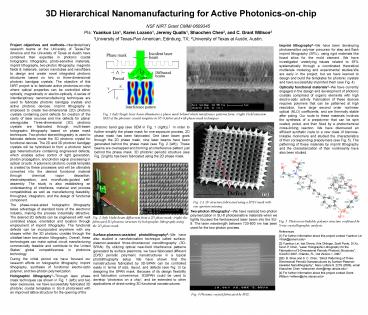3D Hierarchical Nanomanufacturing for Active Photonicsonchip - PowerPoint PPT Presentation
Title:
3D Hierarchical Nanomanufacturing for Active Photonicsonchip
Description:
... of this NIRT project is to fabricate active photonics-on-chip where optical ... We have shown that the nanostructures fabricated by 3D-SPAN can be controlled ... – PowerPoint PPT presentation
Number of Views:122
Avg rating:3.0/5.0
Title: 3D Hierarchical Nanomanufacturing for Active Photonicsonchip
1
3D Hierarchical Nanomanufacturing for Active
Photonics-on-chip
NSF NIRT Grant CMMI-0609345 PIs Yuankun Lin1,
Karen Lozano1, Jeremy Qualls1, Shaochen Chen2,
and C. Grant Willson2 1University of Texas-Pan
American, Edinburg, TX 2University of Texas at
Austin, Austin,
Project objectives and methods--Interdisciplinary
research teams at the University of Texas-Pan
America and the University of Texas at Austin
have combined their expertise in photonic crystal
holographic lithography, photo-sensitive
materials, imprint lithography, two-photon
lithography, magnetic fields materials, carbon
nanotubes and nanofibers to design and create
novel integrated photonic structures based on two
or three-dimensional photonic bandgap crystals.
The objective of this NIRT project is to
fabricate active photonics-on-chip where optical
properties can be controlled either optically,
magnetically or electro-optically. A series of
interdisciplinary nanomanufacturing techniques
are used to fabricate photonic bandgap crystals
and active photonic devices. Imprint lithography
is employed to create two-dimensional (2D)
photonic crystals containing point defects for
creation of the cavity of laser sources and line
defects for planar waveguides. Three-dimensional
(3D) photonic crystals are fabricated through
multi-beam holographic lithography based on phase
mask techniques. Two-photon stereolithography is
used to fabricate defects inside the 3D photonic
crystal for functional devices. The 2D and 3D
photonic bandgap crystals will be hybridized to
form a photonic band gap heterostructure
containing engineered defects, which enables
active control of light generation, photon
propagation, and photon signal processing in
optical circuits. A polymeric photonic crystal
template is created by these processes and will
be ultimately converted into the desired
functional material through chemical vapor
deposition, electrodeposition, and
microfluidic-guided self-assembly. The study is
also establishing an understanding of interfaces,
material and process compatibilities as well as
manufacturing feasibility, throughput,
integration, and the design of functional
component. The phase-mask-aided holographic
lithography takes advantage of standard tools of
the electronic industry, making the process
industrially attractive. The desired 2D defects
can be engineered with well controlled shape,
orientation and location through employment of
imprint lithography. The functional defects can
be incorporated anywhere with any shapes within
the 3D photonic crystals through the ultrafast
laser two-photon lithography. Overall, these
technologies can make optical circuit
manufacturing commercially feasible and
contribute to the United States' global
competitiveness in photonics technology. During
the initial period we have focused our research
efforts on holographic lithography, imprint
lithography, synthesis of functional
electro-optic polymer, and two-photon
polymerization. Holographic lithography1--Through
laser phase mask techniques (as shown in Fig. 1
(left)) and two laser exposures, we have
successfully fabricated 3D photonic crystal
templates in SU-8 photoresist with an improved
lattice structure for the opening of the
Imprint lithography4--We have been developing
photosensitive polymer precursor for step and
flash imprint lithography (SFIL), using rigid
materials like fused silica for the mold element.
We have investigated underlying issues related to
SFIL systematically through a coordinated
theoretical multiscale modeling and experimental
studies.We are early in the project, but we have
learned to design and build the templates for
photonic crystals and have successfully imprinted
them (see Fig. 4). Optically functional
materials4--We have currently engaged in the
design and development of photonic crystals
comprised of organic elements with high
electro-optic activity. Fabrication of these
devices requires polymers that can be patterned
at high resolution, have large second order
nonlinear optical (NLO) coefficients, and are
thermally stable after poling. Our route to these
materials involves the synthesis of a prepolymer
that can be spin coated, poled, and then fixed by
a photochemical cross-linking reaction. We have
discovered an efficient synthetic route to a new
class of biscross-linkable monomers and studied
the characteristics of their corresponding
prepolymers (see Fig. 5). The patterning of these
materials by imprint lithography and the
characterization of their nonlinearity have also
been studied.
photonic band gap (see SEM in Fig. 1 (right)).2
In order to further simplify the phase mask for
one-exposure process, 2D phase mask has been
fabricated. One laser beam goes through the 2D
phase mask, nine laser beams have been generated
behind the phase mask (see Fig. 2 (left)). These
beams are overlapped and forming an interference
pattern just behind the phase mask. 3D photonic
periodic structure (see Fig. 2(right)) has been
fabricated using the 2D phase mask.
Two-photon lithography1--We have realized
two-photon polymerization in SU-8 photosensitive
materials when we tightly focused the femtosecond
laser beam into the SU-8. The laser wavelength
between 720-800 nm has been used for the
two-photon process.
References 1 For further information about this
project contact Yuankun Lin ltlinyk_at_panam.edugt 2
Yuankun Lin, Isai Olvera, Kris Ohlinger, Zsolt
Poole, Di Xu, Kevin P. Chen, Laser Holographic
Lithography for the Fabrication of 3-Dimensional
Periodic Photonic Structures, ICALEO 2007,
Orlando, FL, Oct 29-Nov.1, 2007. 3D. B. Shao
and S. C. Chen, Direct Patterning of
Three-Dimensional Periodic Nanostructures by
Surface-Plasmon-Assisted Nanolithography, Nano
Letters 6, 2279 (2006), email Shaochen Chen
ltshaochen.chen_at_engr.utexas.edugt 4 For further
information about this project contact Grant
Willson ltwillson_at_che.utexas.edugt
Surface-plasmon-assisted photolithography3--We
have also studied a nanofabrication technique
called surface-plasmon-assisted three-dimensional
nanolithography (3D-SPAN). By utilizing optical
near-field interference patterns generated by
surface plasmons, we have fabricated different
2D/3D periodic polymeric nanostructures in a
typical photolithography setup. We have shown
that the nanostructures fabricated by 3D-SPAN can
be controlled easily in terms of size, layout,
and defects (see Fig. 3) by designing the SPAN
mask. Because of its design flexibility and
fabrication convenience, 3DSPAN could be used to
develop photonics on a chip, and be extended to
other applications of direct-writing 3D
functional nanostructures.

